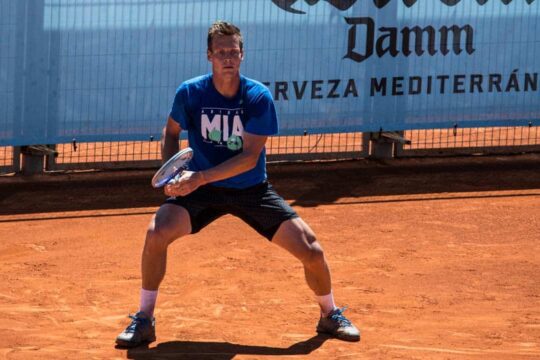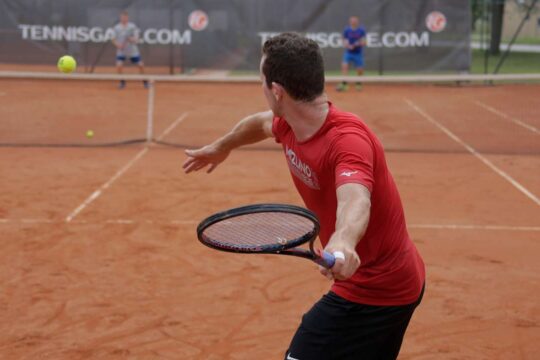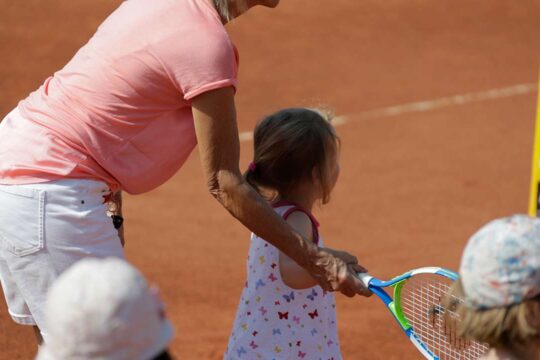How to Improve Match-Play Performance

Tennis, like everything else in life has a set of rules to help you succeed. I call these rules the “Laws of the Battle.” Here are my “Laws of Match Play.”
During the warm up, focus on swinging relaxed and watching the ball, especially after it bounces and all the way to the contact point
Good players use the warm up to prepare mentally and physically for the match. Before a tournament match most players are nervous and tend to fill their minds with anxious thoughts and ideas: How good is this player? I should win this match; he doesn’t look very tough, etc. Focusing solely on the ball will help you keep your mind on the task at hand and will set a good mental base for the competition.
Do not beat yourself. If you lose make sure the opponent has beaten you
The most important two rules in tennis are: Hit the ball over the net and hit the ball within the lines. It is surprising to see how easily people forget these simple rules. Too many times, players are so focused on trying to beat the opponent with great shots that they forget to hit the ball in the court. By the time the match ends the opponent did not have to do anything to win except duck a few times to avoid the fence-seeking “missiles.” Before trying to beat the opponent with clean winners, test his ability by hitting at a pace at which you are comfortable. In other words, play your game first and adjust if necessary.
Set a good base at the start of the match
At the beginning of the match you have to focus on the following aspects: Make all the returns. Play them safely to the middle of the court.Use spin on your first serve to make a high percentage of them. Play mostly neutral shots crosscourt off the ground to get rhythm and to discover what the opponent can and cannot do.
At the start of a match everyone is nervous so the chances to miss are greater. Playing solidly at the beginning will allow you to relax and to test the opponent. If you are nervous and try to play too well from the beginning, chances are that you will make mistakes and become even more nervous. On the other hand, if you make the opponent play at first, you can always play more aggressively if you have to, once you relax. It is amazing how many more matches one can win when one lets the opponent make mistakes.
Try to keep your shots deep and make sure you are not missing into the net
A common mistake is to aim very close to the net especially when hitting hard or attacking, causing many mistakes. Experienced players on the other hand, play high over the net and use spin to keep the ball in the court no matter how hard they hit. A good strategy, in general, is to aim at least two feet over the net on every groundstroke. Not only will you cut down your mistakes, but also, your balls will be more effective by landing deeper in the court.
Play your strengths
Once you establish a solid base try to impose your game style on the opponent. Your first strategy should always be to feel comfortable on the court by playing mainly the shots you like to play. Then you will gain confidence and force the opponent to play on your terms. It is difficult to be a master of all trades. Every player has certain shots and patterns that he/she likes most. Build your game around these strengths and adjust it slightly according to the opponent’s game.
For example, if you like to come to the net, play your match that way but adjust your approach shots based on the opponent’s strengths and weaknesses. You will never see Nadal, the master of clay court tennis, become a net rusher at Wimbledon. He may serve and volley a little more and come to the net a few more times, but he will remain faithful to his basic patterns and game style.
Find the opponent’s weaknesses and patterns
Look for what the opponent can and can’t do. Play to the opponent’s weaknesses. In addition, pay attention to his common patterns of play. Make sure that you are aware of those patterns, especially during important points. For example, if the opponent’s favorite serve is wide, make sure you look for this serve – even stand a bit closer to the side to cover his best serve more easily and force him to try a different serve.
I have heard Wimbledon champion Stan Smith talk about this several times, and his explanation goes something like this: During the match you make a mental note of what is happening; what are your opponent’s tendencies, what is he doing well and what can you exploit? Then wait for key points to capitalize on these tendencies. For example: If you are playing an opponent who is getting very close to the net when he attacks. Wait for a key point to lob. That one lob could decide the match.




